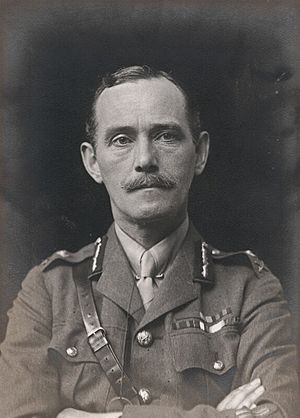Edward Northey (British Army officer) facts for kids
Quick facts for kids
Sir Edward Northey
|
|
|---|---|
 |
|
| Governor of Kenya | |
| In office 1919–1922 |
|
| Monarch | George V |
| Preceded by | Charles Calvert Bowring |
| Succeeded by | Robert Coryndon |
| High Commissioner of Zanzibar | |
| In office 1922–1924 |
|
| Personal details | |
| Born | 28 May 1868 Cockerham, Lancashire, England |
| Died | 25 December 1953 (aged 85) Henley, Oxfordshire, England |
| Awards | |
| Military service | |
| Allegiance | |
| Branch/service | |
| Years of service | 1888–1926 |
| Rank | Major-general |
| Unit | King's Royal Rifle Corps |
| Commands |
|
| Battles/wars | |
Sir Edward Northey (born May 28, 1868 – died December 25, 1953) was an important officer in the British Army. He served during the First World War. He led a group of soldiers on the Western Front until he was hurt in 1915.
After recovering, he returned to duty in 1916. He took charge of a special force in Nyasaland. This force fought in the East African campaign. Later, he became the Governor of Kenya. After his time as governor, he served as a general for the Territorial forces. He retired from the military in 1926.
Contents
Early Life and Military Start
Edward Northey was born in 1868 in Cockerham, England. He went to Eton College and the Royal Military College, Sandhurst. These are famous schools in the UK. In 1888, he joined the King's Royal Rifle Corps as a second lieutenant.
He became a lieutenant in 1890. He took part in military trips to Hazara and the Miranzai Valley in 1891. He also went on a trip to Isazai the next year. He was promoted to captain in 1895. From 1899, Northey fought in the Second Boer War in South Africa. He stayed there until 1902.
After returning home, he worked as an adjutant for a volunteer group. This group was called the 1st Middlesex Rifles.
Service in the First World War
When the First World War began in 1914, Northey was a lieutenant colonel. He served with his regiment, the King's Royal Rifle Corps. He led the 1st Battalion on the Western Front. This was during the first year of the war.
In March 1915, Northey became a brigadier-general. He then took command of the 15th Infantry Brigade. However, he was badly wounded during the Second Battle of Ypres. He was hit in the leg by shrapnel while checking a new trench.
After recovering from his injury, Northey returned to the army in 1916. He was sent to Nyasaland (now Malawi). There, he led the Nyasa-Rhodesia Field Force. This force fought against German troops in the East African Campaign.
For his service, Northey received important awards. He was made a Companion of the Order of the Bath in 1917. In 1918, he became a Knight of the Order of St Michael and St George. This was also the year he was promoted to major-general. Later, he received an even higher honor, becoming a Knight Grand Cross of the Order of St Michael and St George.
Governor of British East Africa
After the war ended, Sir Edward Northey was chosen to be the Governor of the British East Africa Protectorate. This area later became known as Kenya in 1920.
In October 1919, a newspaper reported that Sir Edward Northey had an accident. He was playing polo in British East Africa. The accident was serious and required the removal of his right eye.
During his time as Governor, Sir Edward Northey faced challenges regarding labor practices. There were discussions about how local people should work on farms. The government later clarified that any required work should only be for public projects and with strict rules, not for private farms.
In 1922, Northey was moved to a different role. He became the High Commissioner of Zanzibar. He returned to Britain in 1924 to continue his military career.
Later Career and Retirement
Back in Britain, Northey was given command of the 43rd (Wessex) Infantry Division. This was a part of the Territorial Army. He also oversaw the South West Area of Britain. He performed well in both these duties.
Sir Edward Northey retired from military service in 1926. He lived a peaceful retirement. He passed away in Henley, Oxfordshire, on December 25, 1953.

